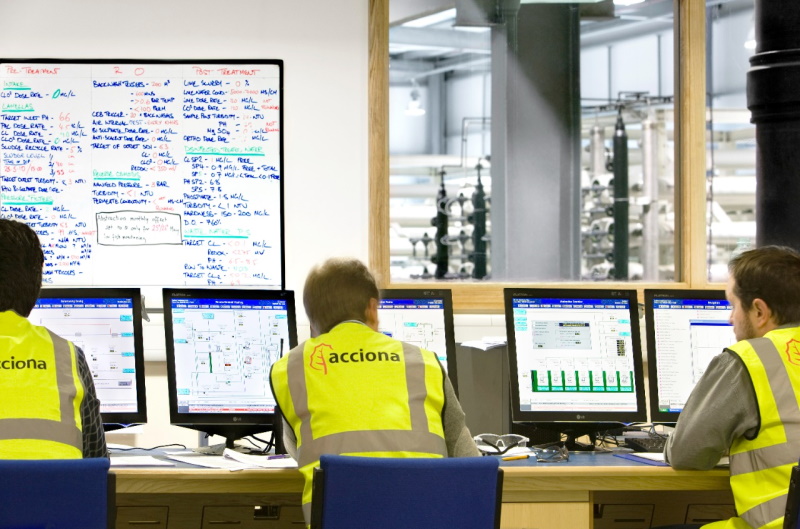
How technology can optimize efficiency in water management processes
By Julio de la Rosa, ME Business Development Director for ACCIONA
Water Management is not only a provided service, it means much more than this: it is an unavoidable human need based in a non-unlimited free resource, supported by United Nations since 2010 and recognizing the right to water and sanitation as a Human Right, therefore the supply of a secure and reliable service in the most efficient and sustainable way must be a top priority for governments.
Regarding efficiency, first view should be directed to new technologies and R+D+i investment needed to allow a quantitative step forward for efficiency in terms of resources consumed for water production, mainly energy and chemicals. We cannot also forget that in arid regions, it is very important to increase efficiency in transportation in order to reduce non-revenue water and efficiency in segregating water standards based in final use.
Consumers need to know the real cost of water supply and treatment as a measure to give water its real value; a different topic is how it is invoiced and paid where resources available for the population need to be considered, being a solution a progressive increase of cost based in individual income level rewarding optimization of consumption.
.jpg)
Reduce the environmental impact of water production and increase sewage treatment and reuse is a necessary for Public Water Authorities, as it is a way of preserving our limited natural resources and a source of wealth for population. Keeping in mind this context, different supporting programs are implementing the latest technologies with less resources consumption and waste generation. We are now applying in the plants Internet of the Things and Big Data, both potable and sewage treatment and water services under construction or operation to know what is exactly happening in every single point of the plant or network. After this, we need a quick decision making process in order to take the best solution rapidly with the help of another promising technology: the Artificial Intelligence.
Water reuse
In the near future, it is crucial to support sewage regeneration technologies to change our view of sewage from a waste to a valuable resource.
Thanks to the innovative technological solutions in the area of water reuse, it is possible to optimize tertiary treatment processes and deliver solutions for the burgeoning demand of water for agricultural uses, urban irrigation, recreational activities, replenishing aquifers, and protecting them from saline intrusion. We are constantly researching technological developments for the reuse of wastewater—one example is biological membrane reactors—to allow for more extensive and sustainable use of purified water.
Besides, this water reuse, depending on the treatment applied, can be full of nutrients that will reduce the use of chemical fertilizers, minimizing the potential impact on natural aquifers. The objective would be to return this resource to the environment with a level of quality similar to or even higher than the one it had before being used, as well as to find a value for the pollutants that the water contains derived from its use.
The catalysts for these eco-designs are without a doubt, innovation, and technical excellence. We have managed to increase the internal consumption of recycled, reused, and rainwater to up to 44% of the total water used in our facilities, based on the principles of the circular economy. In our wastewater treatment plants, we have reached the highest level of reused water, so high efficiency and sustainability are a reality now. In Egypt, in four of our wastewater treatment plants (WWTPs), we have managed to reuse purified water equivalent to that originated from a population of 500,000 inhabitants, and then use it for irrigation.
Transforming sludge into resources
Driven by innovation, solid waste generated in a wastewater treatment plant can be used as a fertilizer for agriculture. The waste removed from the treatment plants has an important content of organic matter and nutrients (mainly nitrogen and phosphorus) that is of high value for agricultural uses. This would contribute to improving the health of soils that need organic matter as well as to close the natural cycle that connects the city with the countryside. A good example where we have applied this principle is at “La Escalerilla” water treatment plant in Arequipa (Peru).
Sludge generated at sewage treatment plants is rich in natural minerals that can be used as well as a fertilizer.
Our RAMSES Project, which emerged as a result of implementing efficient solutions to continue re-using the treated wastewater effluent as a main source of irrigation water proved to be so necessary for areas of great water stress. As quality requirements for re-generated (effluent) water used for irrigation becomes more demanding, we shall need additional processes that will push treatment costs upwards. Therefore, it is our duty to continue working on technologies and processes that enable wastewater for agriculture to be re-used efficiently, considering the responsibility we have as a leading water treatment company to fight the global warming that our planet is suffering. Another strong point of the project is that it sets out to maximize resources, re-using many of them again in the same process and thereby promoting its circular nature.
The RAMSES Project - named by combining part of the initials of the full name in English (Enhanced Reclaimed Water quality through Mainstream and Aerobic treatment using Supported biomass growth) - developed by ACCIONA, has been partly funded by the European Commission through the LIFE program and carried out in a WWTP at the South of Spain.
Technology for prediction
We have developed a predictive model for seawater quality that is improving the operation of Sea Water Reverse Osmosis (SWRO) plants in the region using satellite measurements and Artificial Intelligence tools to forecast the quality of water reaching desalination plants allowing us to be ahead of a potential problem to fine tuning the plant to the most efficient and sustainable point. Algae bloom, oil spills and jellyfish are just some of the phenomena that can clog the filtering systems of desalination plants and cause operations to shut down. But with sufficient warning, desalination plants can stop extraneous matter from entering filtering systems.
To forecast when desalination plants might be at risk from algae bloom and other events, ACCIONA used NASA’s Modis Aqua Satellite to collect data from the Persian Gulf from a number of parameters including water temperature, chlorophyll levels, salinity, and turbidity – a measure of the clarity of water.
The satellite uses different sensors including radar, infrared sensors and high resolution photography to compile the data. ACCIONA’s Control Center for its water business, CECOA, uses the satellite data to model a Turbidity Prediction index, which compares the clarity of the water in real time with historical oceanographic and meteorological data. When the index exceeds a certain limit, it triggers a warning for operation and maintenance staff to prepare for an algae bloom or similar event.
With this model, we can forecast the future turbidity of seawater, and this gives our operations teams advance warning of any event that could compromise operations or scheduled maintenance activities. This project was launched in 2020 and has been implemented in SWRO plants in the Middle East.
CECOA- Virtual analysers and predictive models
The connection of the Ras Abu Fontas A3 and Umm Al Houl SWRO plants with CECOA (our Water Control Center based in Madrid, Spain) allows ACCIONA to process thousands of data generated on-site. Using state of the art, bid data, IoT, Machine learning and artificial intelligence tools, ACCIONA has developed virtual analysers for the plants in Qatar to be able to understand in real time the value of some product water quality parameters or to be able to predict the behaviour of some of the incoming water characteristics. These results in a more efficient operation and increased availability provided to our clients.
As the global population hurtles towards 9.7 billion people by 2050, it has never been more important to produce more with less. And it is a fact that innovation and technology have a vital role to play in scarcity and safety, water efficiency, utility operations, monitoring and treatment and data and analytics.


























